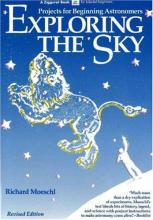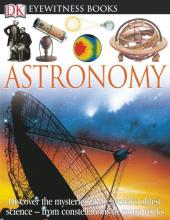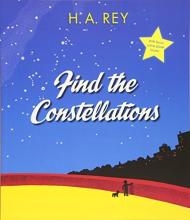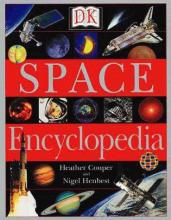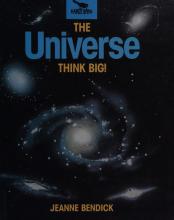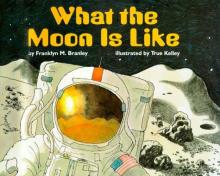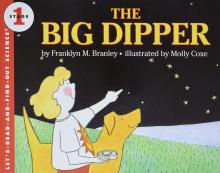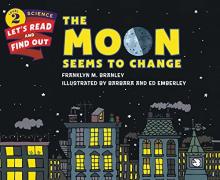Astronomy
Exploring the Sky
As your student begins to look skyward and ask questions, take them in one hand and this book in the other! With this book, an assortment of ordinary household things, binoculars or a telescope, and lots of time you can teach a fascinating, hands-on course in beginning astronomy for an entire year. Exploring the Sky is not a textbook. It isn't a storybook. It IS a living book guide to exploring the heavens with an interesting mix of history, biography, folklore, legend, science facts and science fiction, and even some mathematics and art. Obviously written by someone who loves the subject, Exploring the Sky makes the subject come alive.
Introducing a broad range of subjects, this book is organized into seven lengthy chapters with four topical sections each, and a total of seventy-two projects. This is hands-on, time-consuming, attention-grabbing, messy science, not read-about-it science! These sections begin with background information on the topic and at least one project, although most sections include several projects. For example, Chapter 5 is titled "Sky-Gathering Tools". Section 3 is titled "Cameras" and includes presentations on photography with a project on photographing stars and planets, the photoelectric effect, and computers with a project on showing how images are transmitted. This is followed by "Observations", critical thinking questions designed to elicit connections from the student. Often, there are suggestions for additional books to read and browse on the topic as well. Many of the suggested books have copyright dates between 1960 and 1980 and would be best located at the library. It is possible to simply dive in, choose a chapter or a section of a chapter, and begin exploring. The toughest decision is where to begin! How difficult it is to choose among constructing a sundial, demonstrating how the colors of the sky are make, experimenting with prisms, making a model of a black hole, or creating craters on Mercury.
As with all secular books on astronomy, there are references to millions of years of time, but there is no particular emphasis on evolution. Creation legends are retold from cultures as diverse as those of Babylonia, the Norsemen, Mexico, the Maori, and Greece but there is no mention of Christian teaching. Catholic children at this age level shouldn't have trouble making essential distinctions and will probably find value in contrasting this section with the book of Genesis and other sources of Catholic teaching.
This book is noted on the cover as being for "talented beginners", but it is for beginning astronomers who are middle-school-aged students and above, not beginning students in the elementary grades. Basic skill with multiplication and division, as well as the ability to use reference tables that are provided in the book, is necessary to understand some of the projects. Although there are numerous diagrams and sketches, the only thing missing is color photographs. I'm guessing that printing in black and white contributes to keeping such a valuable book so inexpensive. Thus, the only supplements that I suggest are Internet photographs (such as those on the NASA site) or books in Seymour Simon's space series.
Eyewitness: Astronomy
Although most books in the DK Eyewitness series are at least slightly problematic in the text, our family enjoys a number of them entirely for the sake of the pictures. Eyewitness: Astronomy is one of the ones I wouldn't bother with even for the pictures. Although there are many beautiful photos, the book overall is both disappointing and even problematic in places. In looking for a book about astronomy for my children, I wanted something that covered the facts about stars, planets, galaxies, etc., with beautiful photos and interesting text about what science knows (or believes) so far - particularly from the starting point of what children are able to see from their own observation or from straightforward photos and illustrations.
Although there is a certain amount of basic science covered here, I thought there was an exorbitant emphasis on astrology and how it developed into astronomy and a lot of history of science details (some of which is disputable.) I thought the DK Space Encyclopedia (reviewed here) was much nicer (and certainly more thorough) in what it covered and even showed a much fairer hand in dealing with Church-related issues such as Galileo.
Find the Constellations
I've always loved looking at the stars, but have never been able to identify anything but the big dipper on a starry night. For many years, I've wanted to learn more, but with the busyness of life, this goal has long eluded me. Enter ... Find the Constellations by H.A. Rey. Over the past few weeks, my two oldest children and I have started identifying the constellations with the help of this book and The Stars: A New Way to See Them (by the same author). We've had a great deal of excitement and enthusiasm around 10:00 pm when I summon those children who are still awake to see if we can find anything. With flashlight and books in hand we step outside into the dark. We look up and start to focus. After studying the pictures ahead of time, several constellations start jumping out. We move back and forth between book and sky and the excitement increases. Well, we haven't learned lots yet, but we are now able to identify five or six constellations and are slowly increasing our base knowledge.
This simple book is very child-friendly and moves the reader back and forth between what the stars really look like and simple, memorable stick figures to help keep them (and their names) in our heads. One helpful feature in the carefully drawn charts is the differentiation between brighter and less-bright stars (a very important feature in identification). The book includes some quizzes to help children remember the constellations better and, again, differentiate between the stick-figure drawings and the actual "look" of the constellation. The author also includes: some of the stories behind the naming of the constellations; information about the changes in our sky view at different times of the night and different times of the year; tips for star-gazing; and overviews of the planets in our solar system and tips for viewing them. The book wraps up with some interesting information about what it takes to travel to the moon or to Mars as far as distance, speed and navigation goes. He takes this back to the idea of why it is a good thing to learn the constellations.
All of the information in this book is aimed at viewing the night sky with the naked eye rather than a telescope. There is an extensive index in the back which includes the Latin and Greek names of the constellations (such as Ursa Major and Bootes), but the text uses the English names (except for specific names of stars, such as Vega and Arcturus). The book has been revised numerous times since 1954 and the most recent edition includes location of the planets through 2006. Highly Recommended!
Revised many times since original publication, the book details here are for the 2016 edition.
Space Encyclopedia
We've started working our way through parts of this book as a read-aloud for younger children but have enjoyed it especially for the pictures. It covers everything from the Hubble Space Telescope to the surface and atmosphere of the Sun, Moon and Planets, from Space Pioneers to star maps, from explanations of various types of telescopes to black holes and discussions of the possibility of extraterrestrial life. We've only read a small portion of the text so far, but were pleased to find that the text came out better than expected in several litmus-test areas. The detailed charts on things you can see in the night sky was very helpful.
The Universe: Think Big!
Jeanne Bendick, author of Archimedes and the Door of Science, explains some basic concepts regarding the universe in a surprisingly simple way (approximately 2nd grade reading level - short pages with large type). First she invites children to try to imagine how big the universe is (in terms of it being much, much bigger than other, more familiar things). The bulk of the book focuses on large distances and how they're measured and how people used to believe that the earth was at the center of the universe and remained motionless. The final page explains the big bang theory. For a controversial topic it is explained rather nice in terms of "How did the Universe begin? Nobody knows for sure, but here is what most scientists of today think." Although the big bang theory was first thought of by a Catholic priest (LeMaitre) who was trying to point toward something which God created, we all know that the big bang theory is often used to try to explain God away. Young children don't have much trouble with this when presented as it is in this book. After the book says "Suddenly, this object exploded with a big bang," you can ask your children, "If this is the way the Universe really did begin, then who made the explosion happen?" Chances are, they'll know the answer. :)
What the Moon is Like
This book covers the appearance of the moon from the earth (in regards to its surface rather than its changes over the month), the explanations people have given for the appearance of the moon (man in the moon, etc.) and why it really looks that way. It covers many interesting details about the surface of the moon (including a simple map of the moon's surface marked with the locations of moon landings), its atmosphere, the length of day and night on the moon (and the extreme temperature difference between the two), the difference in gravity on the moon, etc. The book is fully illustrated and quite engaging although I think some of the ideas on how the moon was formed are still open for discussion. A final page offers a few simple moon-related projects and a few related websites for further information.
First published (copyright) 1963. Many later editions.
The Big Dipper
A very simple science book for children with cartoon-like pictures (nice cartoon, not cheezy-cartoon) that introduces some basic concepts about the stars. The very simple story line discusses looking at the night sky, that you see different stars in the summer and winter, where the big dipper got it's name, the names of the stars that make up the big dipper, how people can find direction from the North Star and the traditional constellation Ursa Major that the Big Dipper belongs to. The language is very simple, but not at all dumbed down - especially appropriate for preschool.
The Moon Seems to Change
This book, through simple illustrations and very readable text, gives young children (approximately Kindergarten thru third grade) an excellent explanation of the moon and the changes we can easily observe in it during a month. What often seem like complex concepts - the phases of the moon and its movement relative to the earth - are made very understandable through the text and a very simple experiment involving an orange stuck onto a pencil (a styrofoam ball stuck onto a chopstick worked quite well for us with less mess) and a flashlight. Naturally, it's recommended to do some real observations along with the book.
Many editions, 1960 onwards.

